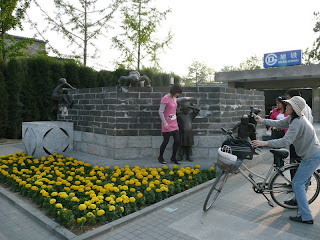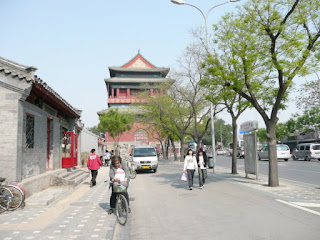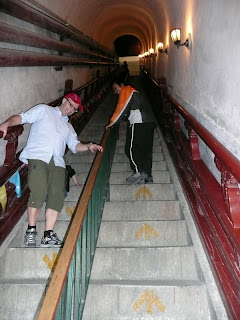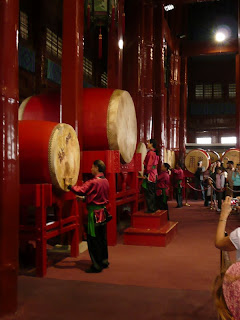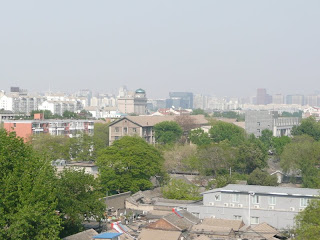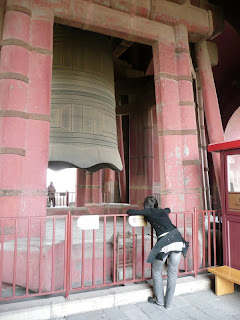As it happens,
chop suey doesn’t seem to exist in China. I’ve read something about the name translating as “mixed bits” or something like that – it’s not Mandarin, probably Cantonese. Anyway, the title is chosen in the hopes that it really does mean “mixed bits” since it’s one of those miscellaneous scattered posts without a single theme.
Come 1 May I discovered that my internet connection didn’t like my password anymore. It hasn’t happened in a while, but my landlord forgot to pay the ISP again. It’s not like I needed any excuses to stay at the office long hours. And the internet at the office is slower for many things than my connection here.
Today’s topics include work, food, Chinese (the language) and Chingrish. Oh, yes, and harmonicas.
Phase 1: WorkThe reason it’s been busy at work lately is
this. Things went much better than last time, and we managed to sell more than a half million tickets in the first day, which may very well be a feat no ticketing company has ever accomplished. Around 5pm the day before, we started hearing stories about people queued up at Bank of China branches for the 9am opening. Those of you who have purchased tickets in the US and Europe will no doubt know that buying online is a far better option, but the system was set up to give a fair chance to people without computers or access to the internet.

Our Help Desk was up to full strength all day, answering questions coming in from bank branches. This was a very noisy room.
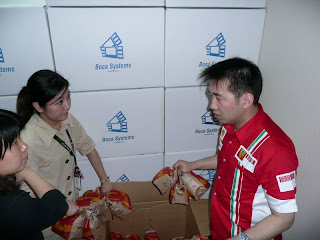
We got two big boxes of food from McDonald’s and KFC to feed the crew.
Within the first two days, essentially all the tickets to events in Beijing had been snapped up, and only the events in other cities are still available.
OK, enough of that. On to...
Phase 2: FoodI’ve mentioned a dish called
jinjiang rousi, and my description brought on a request to see what the it looks like. Well, here it is, TC. It’s the one on the right.
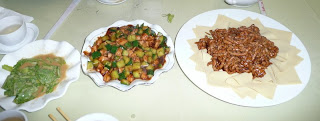
It’s pork cut in thin strips (
rou means meat, and
si refers to this style of cutting).
Jinjiang is the sauce, apparently. I don’t know what the word means. I’m told it’s a Beijing specialty, possibly of recent invention rather than a traditional dish like roast duck. The sauce is not spicy, but savory, and quite similar to Peking Duck sauce. Soy sauce is likely a main ingredient. Under the meat you find some thread-cut onion, just as with duck. The wrappers are made of bean curd, essentially thin dry tofu. You roll up the meat and onion in the wrapper and eat it, which can be a challenge with chopsticks even for an experienced user.
The dish on the left was some kind of lettuce in a nice sesame flavored sauce. In the middle is chicken with cucumber and a tiny amount of red pepper.
That was one day’s lunch. On another day, a coworker told me she really wanted to have
kaoyu, roast fish, from a restaurant on
Gui Jie. I think I’ve mentioned Ghost Street before – it’s the nickname for one of the major streets that lies between the office and my apartment. It’s a little further than we usually go for lunch, but for
kaoyu you make the effort.
We got to the restaurant before noon and were the first ones in there. This might normally be a warning sign that the food isn’t very good, but my companion had eaten there before and assured me it would be worth it. There were four or five different kinds of fish on the menu, sold by the kilo. We picked one that cost ¥38. Then you select what kind of sauce you want from four-pepper spicy down to mild. We picked the spiciest one. Then you pick what will be roasted with the fish, and we got some greens and mushrooms. A couple of bowls of steamed rice, and there’s your meal. The waiter brought the wiggling fish out for our approval in a net. It was about 3kg.
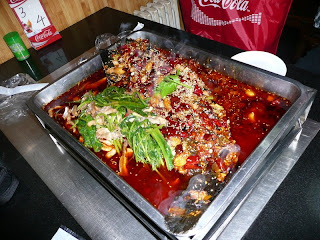
And here’s what it looked like when prepared. All I can say is yum. Definitely a meal to remember. I wonder if you can get this in America... In case you can’t tell from the picture, it’s covered with hot red peppers and garlic cloves along with onion and
huajiao, the Sichuan flower-pepper I’ve mentioned before that has a numbing effect on the mouth. This taste, the combination of numbing peppers (
ma) and hot peppers (
la) is called
mala, and it is quintessentially Sichuan. It was not the spiciest thing I’ve ever eaten, but it was up there, and oh, so delicious – surprisingly the spice did not overpower the fish and vegetable flavors.
Feichang haochi!This is what it looked like after a half hour or so:
 Phase 3: Mandarin
Phase 3: MandarinIn the midst of all the work, I’ve managed to continue my Chinese lessons. None of my coworkers who previously studied with me had time to join me, so I’ve got private lessons twice a week most weeks. I’m learning all sorts of things to stretch my poor brain, and I try to use them enough that they stick.
The really exciting thing – to me at least – is that I’ve finally progressed far enough to start learning to read and write some of those strange characters.
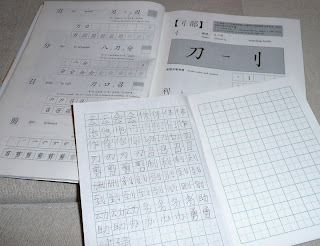
This is my textbook along with my little practice book and my pathetic scribbles. I’m sure the average Chinese third grader makes me look like an idiot, but you have to start somewhere.
One amusing thing is that when she gives me dictation (she says words and I write the characters), sometimes I do the writing on her mobile phone. She starts a text message, and I type in the Chinese. It’s easier than you might think. You type the phonetic spelling (pinyin) for each syllable, and the phone presents a little menu of all the possible characters. You use the arrow keys to pick the right one. That way I don’t have to worry about penmanship.
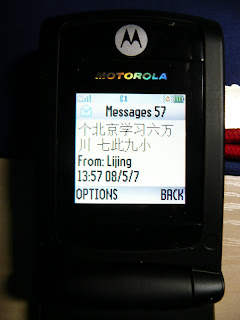 Phase 4: WTF?
Phase 4: WTF?I’ve come across two really wonderful examples of bad Chinese English lately, and unfortunately I was not able to get pictures of either one. I saw the first one while riding in a taxi. We were stuck in traffic, and I looked up from my Blueberry long enough to puzzle over the bumper sticker on the car ahead of us. Apparently the owner loves his or her dog. The blue sticker had the white outline of some kind of terrier and these letters.
WEET HIGFLANG WFTERRIER
I cleaned my glasses to make sure the letters weren’t getting mixed up with smudges, then I opened up a note on the Blueberry and carefully typed in the letters exactly as I saw them.
The other one was at a subway station. I saw a nice looking young woman wearing a pink T-shirt with big block letters on the back:
HOLE
LOTTA
LOVE
At first I thought her long hair was covering up the missing letter, but no. That’s what it said. I’ll just leave this one without further comment. Please believe me that I actually saw this.
Phase 5: The Nanguan Harmonica Club and Dance AuxiliaryI have noted before that I often find harmonica players in Nanguan Park. Heck, you only have to go back one post to find it. The other night I was walking home for the office after dark, and the music was louder than usual in the park, and there was a crowd of several dozen people gathered.
I counted eight harmonica players plus one guy playing a bamboo flute. There were two women in costumes dancing to their music. Tonight I got there just before the 9pm closing time, and there was quite a racket coming from the park. In addition to the harmonicas (I couldn’t tell how many, but there were at least three dancers), there were about a dozen people singing, complete with different parts for the men and women. And since too much is never enough in this town, there was a group across the pond dancing to pop music blaring out of a boom box, plus the recorded announcement that the park was closing, which was accompanied by an old pop tune I couldn’t quite place (the backing chords are a lot like “Moonlight Sonata”). Add that to the music I had playing in my earphones, and it was quite a sonic collage.
Stay tuned for some more adventures, including a (gasp!) touristy place.
 It’s in the central part of town, right next to the Great Hall of the People.
It’s in the central part of town, right next to the Great Hall of the People.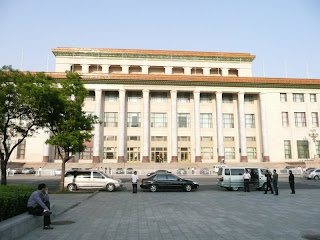 Which is next to Tian’anmen Square, just south of the Forbidden City. In other words, it’s surrounded by the landmarks of previous centuries. There have been many complaints that this expensive structure just doesn’t fit in, and that something more conservative would have been more appropriate. I’ll admit it looks a little odd, but it’s so cool I don’t care whether it fits in or not.
Which is next to Tian’anmen Square, just south of the Forbidden City. In other words, it’s surrounded by the landmarks of previous centuries. There have been many complaints that this expensive structure just doesn’t fit in, and that something more conservative would have been more appropriate. I’ll admit it looks a little odd, but it’s so cool I don’t care whether it fits in or not. It’s completely surrounded by water, and the entrance is a glass-ceilinged corridor under it.
It’s completely surrounded by water, and the entrance is a glass-ceilinged corridor under it. To either side of the corridor are exhibits dealing with the performing arts, both in China and in the rest of the world.
To either side of the corridor are exhibits dealing with the performing arts, both in China and in the rest of the world. Inside the Egg is as amazing as you might expect.
Inside the Egg is as amazing as you might expect.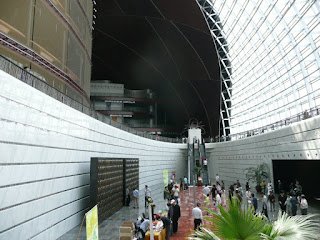 This was on a Sunday afternoon. For ¥40 you can come in, wander around, and catch some of the many informal events taking place.
This was on a Sunday afternoon. For ¥40 you can come in, wander around, and catch some of the many informal events taking place. We caught an organ recital involving a really impressive pipe organ. Any guesses what piece she played first?
We caught an organ recital involving a really impressive pipe organ. Any guesses what piece she played first?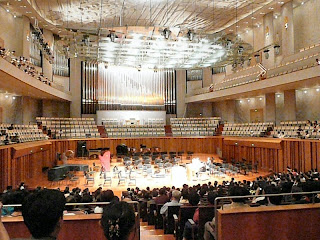 Up at the very top of the structure is an area that can be used for receptions and small performances.
Up at the very top of the structure is an area that can be used for receptions and small performances.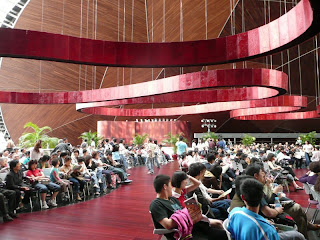 This is about five stories up.
This is about five stories up. It’s a long way down to the entrance.
It’s a long way down to the entrance. Back down on the main level there was a string quintet playing an arrangement of an ancient Chinese song about the legendary Butterfly Lovers.
Back down on the main level there was a string quintet playing an arrangement of an ancient Chinese song about the legendary Butterfly Lovers.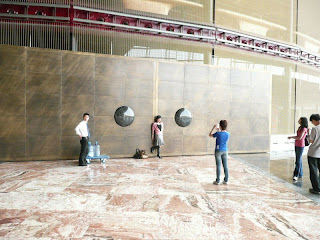 This massive barrier is actually one of the doors into the main auditorium. It’s patterned after traditional Chinese doors.
This massive barrier is actually one of the doors into the main auditorium. It’s patterned after traditional Chinese doors. It’s also really heavy. Two of the sweeping ladies had to help the water delivery guy open it. The main auditorium was not accessible. I guess maybe I’ll have to get a ticket to a real performance to see in there.
It’s also really heavy. Two of the sweeping ladies had to help the water delivery guy open it. The main auditorium was not accessible. I guess maybe I’ll have to get a ticket to a real performance to see in there.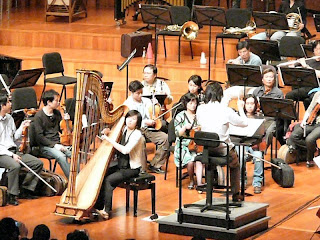 After a while, we went upstairs to check out the view from the balcony.
After a while, we went upstairs to check out the view from the balcony. Once back outside, I walked all the way around to see if from various angles.
Once back outside, I walked all the way around to see if from various angles. Pretty darn cool, I’d say.
Pretty darn cool, I’d say.
